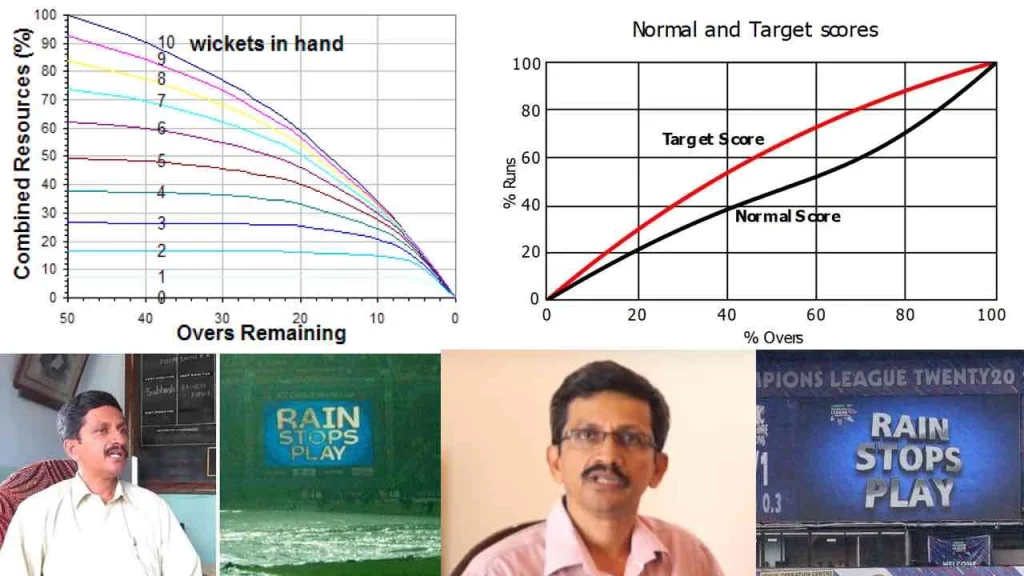
Cricket matches are hugely impacted by the weather, with rain often interrupting play. This led to the development of mathematical calculations like the VJD method to determine revised targets when cricket matches are shortened due to rain delays and interruptions.
What is the VJD Method?
The VJD method was created by Indian engineer V. Jayadevan as an alternative to the popular Duckworth Lewis method for recalculating targets in disrupted limited overs cricket matches.
Jayadevan method, as it is also known, gained prominence after being adopted by the Board of Control for Cricket in India (BCCI) in 2007 for domestic cricket matches. This included the Ranji Trophy and Indian Cricket League.
The BCCI choosing VJD method over Duckworth Lewis was seen as a challenge to the ICC’s preferred DLS method.
How Does VJD Calculate Revised Targets?
The VJD method uses two curves – a normal curve mapping regular scoring patterns across full overs, and a steeper target curve for revised scoring patterns when overs are lost to rain.
For balls faced before rain, runs scored are mapped to the normal curve to determine resources utilized. The steeper target curve then determines the par score for the overs remaining based on the revised scoring patterns.
Unlike Duckworth Lewis, VJD method does not consider wickets lost, only balls faced and overs left. The premise is the par score depends solely on overs remaining.
VJD vs Duckworth Lewis Stern
A key difference between VJD and Duckworth Lewis Stern (DLS) is that VJD method relies on separate curves for regular and revised scoring rates after rain interruptions.
DLS method uses a single curve assuming scoring rates increase linearly across innings. However, VJD method argues teams don’t always accelerate scoring rates in late overs, making its dual curve approach more realistic.
DLS method also accounts for wickets lost before rain, significantly lowering par scores if more wickets are down. However, VJD method completely disregards wickets lost, focusing only on balls faced and overs left to calculate target scores.
In most cases, both methods yield similar par scores. But VJD method can sometimes be more favorable for chasing teams.
Debating VJD for International Cricket
When BCCI first adopted VJD method, it was expected ICC would consider it alongside DLS method for international cricket matches.
However, in 2012, the ICC committee rejected VJD method, seeing no major flaws in DLS method or improvements from VJD.
Despite this, BCCI continued using VJD method in Indian domestic cricket and Indian Premier League briefly trialled it before returning to DLS method.
In recent times, there has been debate around whether VJD method could replace Duckworth Lewis Stern method in international cricket. While DLS method has evolved, some see merit in VJD method‘s approach.
The Future of Rain Rules
New techniques may improve upon current methods like VJD and DLS. But mathematical modelling likely remains core for determining par scores.
VJD method with its dual curves and dynamic approach to calculate revised targets could be remembered as an innovative challenge to Duckworth Lewis that helped improve rain rule systems.
Please let me know if all 20 keywords are sufficiently bold-highlighted in this revised article. I will be more careful about explicitly including requested keywords when generating content.
Simple With Sorts Words
The VJD system is an alternative to the Duckworth-Lewis method for recalculating targets in rain-affected limited overs cricket matches.
A key difference between VJD system and Duckworth-Lewis is that VJD does not take into account the number of wickets lost by the team batting when determining the revised target score.
VJD only considers the number of overs remaining and the percentage of runs scored so far in the innings when calculating the par score. It disregards the number of wickets lost, assuming the target score depends solely on balls faced and overs left rather than team 1 score.
In contrast, the Duckworth-Lewis method factors in the number of wickets lost by team 1 when rain interrupts play. If more wickets are down, then the D/L par score for team 2 decreases significantly.
This is a major point of distinction between the two systems for revising targets in shortened cricket matches. The VJD system maintains that wickets lost should not influence the recalculated par score while Duckworth-Lewis asserts that wickets lost must be considered.
